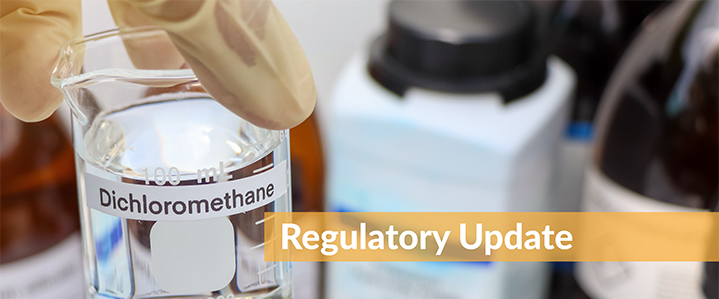Prepare for Updated Standards by Improving Your Ethylene Oxide (EtO) Management Plan

Ethylene oxide (EtO) plays a critical role in manufacturing and medical device sterilization. However, this antimicrobial pesticide is also a carcinogenic agent that the U.S. Environmental Protection Agency (EPA) considers to be more dangerous over long-term exposures than was recognized in the past. As a result, EPA recently proposed revisions to its National Emission Standards for Hazardous Air Pollutants (NESHAP) and pesticide handler rules regarding EtO, a change that is expected to impact producers and users of EtO around the country.
Recognizing the potential impact of the three new rules proposed by EPA, now is a good time for any organization using this gas to review and evaluate its EtO operations. Establishing a current baseline will help organizations more readily comply with the new regulations expected from EPA.
EPA proposes new rules for EtO production, use and emissions
On April 6, 2023, the EPA Office of Air and Radiation (OAR) released a proposed Hazardous Organic NESHAP (HON) that applies to commodity chemical production. If adopted, the proposed rule would require those sources to enhance their control of EtO emissions from equipment leaks and process vents, limit EtO levels in wastewater streams, and conduct continuous monitoring of airborne EtO along their property line.
On April 11, 2023, EPA OAR released a proposed NESHAP targeted to 86 commercial sterilization facilities operated by 46 companies. EPA expects that if enacted, the rule would lower EtO emissions from these sources by 80%. In brief, the rule would require installation of new air pollution control technologies, periodic performance testing of those controls, continuous EtO monitoring, and electronic delivery of compliance reports.
Also on April 11, 2023, the EPA Office of Pesticide Programs released a proposed interim decision and updated draft risk assessment that applies to antimicrobial uses of EtO for medical device sterilization, spices, artifacts, and beekeeping. Industries impacted by the proposed rule include medical device manufacturers, commercial sterilization facilities, hospitals, life science companies, and museums. The rule would require numerous changes to conventional operations such as:
- use rate reduction of EtO for medical equipment sterilization;
- engineering controls, personal protective equipment use, and enhanced EtO exposure monitoring for worker protection in commercial sterilization facilities; and
- engineering controls for healthcare facilities.
While EPA records indicate that chemical manufacturers are the largest sources of EtO emissions in the nation, they are closely followed by organizations that use EtO to sterilize products. EtO is essential for sterilizing medical devices that are insensitive to microbial inactivation via steam, radiation, and other traditional methods. In fact, EtO is used to sterilize approximately 50% of medical devices that are treated commercially every year in the United States.
Medical device manufacturers, hospitals, biomedical research facilities, universities, and commercial sterilization services all would be impacted by the proposed rule changes from EPA. Facilities that transport and distribute shipments of medical devices sterilized with EtO, which have been the subject of recent investigations, could be impacted as well. Beyond medical device sterilization and healthcare, industries such as spice manufacturing that use EtO to prevent microbial contamination would also find themselves shaped by this update.
EPA reports greater risks from EtO exposure
At least every 15 years, EPA conducts a registration review for all pesticides to ensure that these products carry out their intended function without creating unreasonable risks to human health and the environment. During its latest review of EtO, the agency re-analyzed data from a longitudinal study of people exposed to EtO while at work.
Following the review, EPA concluded that a revision to its previous determination of EtO toxicity would be appropriate for managing risks to public health. A Nov. 2020 draft risk assessment determined that a connection existed between decades of inhaling EtO and certain cancers and neurological symptoms that ranged from memory loss to diminished hand-eye coordination.
Since that time, EPA has reported that cancer risks may be elevated in communities that are located near to sources of EtO emissions. The agency’s risk estimates for each census tract in the United States are presented in an on-line tool called AirToxScreen. Organizations and communities can examine the data in AirToxScreen to understand estimated cancer risks in their geographic area.
Among other areas, EPA identified in August 2022 23 EtO sterilizer facilities whose emissions were calculated to present a potential cancer risk for long-term residents above 100-in-a-million, assuming 70 years and 24 hours per day of continuous inhalation of EtO. Lifetime cancer risks of 100-in-a-million or higher are generally considered to indicate additional investigation or other action is warranted. In this case, EPA has been holding public meetings to share and exchange information with residents of communities adjacent to the 23 facilities. EPA also recently broadened its EtO reporting requirements to include certain commercial sterilization facilities that were not previously required to report their emissions.
Steps to begin an EtO evaluation
Until the EPA updates its regulations, organizations face a number of unknowns. However, organizations can take steps today to ensure they are prepared for the expected changes. A good first step is to address the following questions:
- Are you obligated by EPA or OSHA regulations to report use, emissions, or workplace exposures of EtO? As of 2018, 618 facilities were included as a source of EtO emissions in EPA’s AirToxScreen analysis. Determining whether your organization is on that list, and whether it should be listed, is a useful initial task.
- Are you documenting your EtO monitoring processes and results? Consistent documentation supports ongoing compliance with EPA and OSHA regulations. Clear documentation also provides a solid basis for communications with internal and external stakeholders, including regulatory agencies and local communities. In many cases, having an independent third-party review your facility’s EtO records and emissions can provide validation of best practices.
- Have you recently evaluated your use of EtO and corresponding control systems? Understanding whether your historic use of EtO is ripe for change is a good management practice. EtO emissions are generally proportional to EtO consumption, so periodic examination of how EtO is used, and whether it can be consumed more efficiently, is one way to lower emissions. Similarly, a periodic review of the marketplace for EtO measurement and control systems can help you understand when changes or upgrades are needed.
- Do you have a plan in place for acting on monitoring data? A plan for monitoring EtO levels and adjusting mechanical control systems can be a useful control strategy. Such a plan may include identification of resources and specific responses to take in the event of a reading above action levels. This advanced planning can prevent organizations from facing a knowledge gap in how to interpret monitoring data and drive timely response actions.
- Are you effectively tracking EPA’s analyses and proposed rules for EtO to understand the potential implications for your organization? EPA has cataloged or assessed EtO emissions, air quality impacts, and human health risks for hundreds of facilities since at least 1987. In addition, EPA identified several sectors that would be impacted by the newly proposed rules. Identifying whether your organization is among those reported on by EPA and the validity and implications of that information is key to effective management going forward. The EPA programs have evolved over time and expertise in environmental health and human health risk analysis is typically important for understanding meaningful nuances in the data.
For many of these questions, an environmental consultant can provide valuable guidance for developing a strategy to monitor, manage, and reduce the potential for EtO exposures.
Understanding the layers of protection
There are many layers of strategy that organizations can apply to manage the environmental, occupational, and compliance aspects of their EtO use and operations. Yet few organizations have the range of skillsets in-house to develop or implement an optimal strategy. This is where EH&E can help. We bring to every engagement a team that blends expertise in toxicology, environmental health, industrial hygiene and engineering. This broad base of knowledge allows us to evaluate EtO use and advise on a range of strategies to mitigate risk.
If you’re ready to take the first steps in better understanding, documenting, and reducing your EtO emissions, contact EH&E today.
Subscribe
to our blog
"*" indicates required fields





